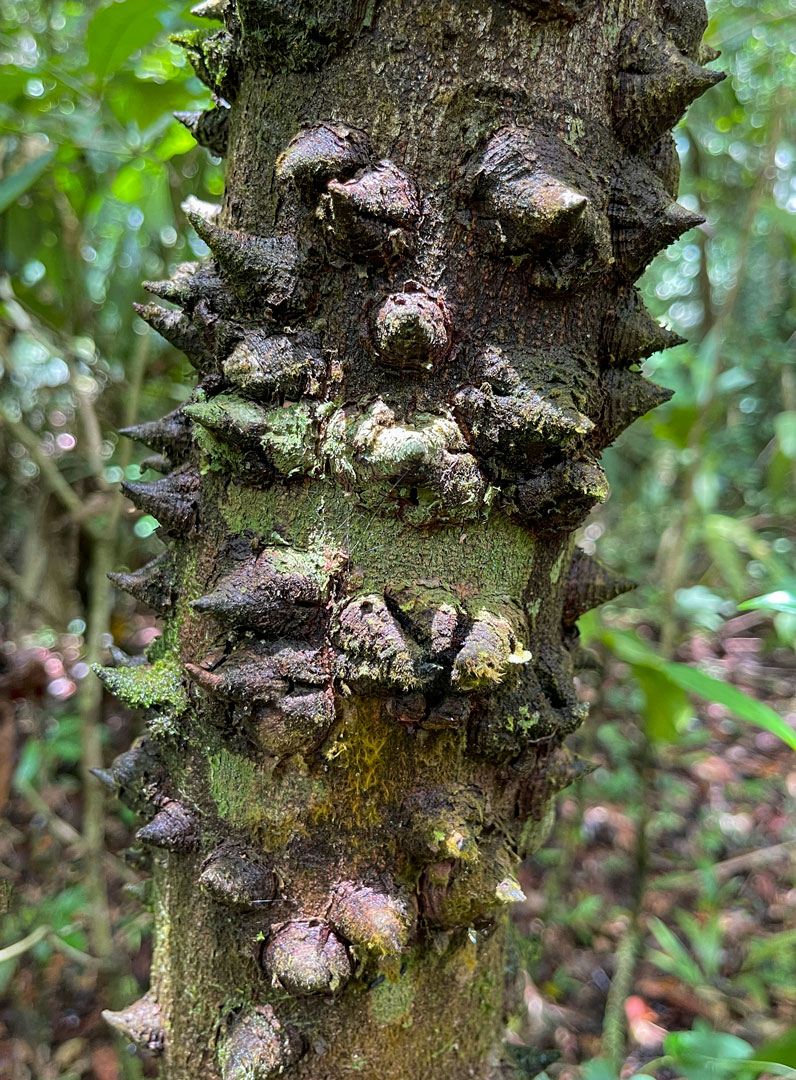Genera description
Lacmellea standleyi (Apocynaceae) is commonly called as palo de vaca, lechemiel, milk tree, prickly vaca or vaca tree. It can grow between 5-12 meters high; has logs usually with stringers; twigs flattened when young, cylindrical with age, glabrous. Leaves with petioles 6-10 mm, glabrous or glabrescent. Inflorescences with 4-10 flowers, glabrous or glabrescent. Flowers with calyx lobes 1.5-2 × 2.5-3 mm, rounded, glabrous, sometimes diminutively ciliate; corolla white to creamy-white. The fruit is a green berry rounded (2-2.5 cm of diameter), when mature it turns into a dark yellow color with soft pulp of sweet flavor (Missouri Botanical Garden & Tropical Plants Database).
Uses
The fruits are edible and a latex is obtained from incisions in the stems which is drinkable. In addition, the research “Bioprospecting of Lacmellea standleyi fruits (lechemiel)” (listed in this bibliography) confirm that the fruit has antioxidant capacity and a high nutrient content, suggesting a promising future in the pharmaceutical industry.
Lacmellea standleyi, leche miel, photographed in Tapon Creek, Livingston with an iPhone 12 Pro.
PDF, Articles, Books on Lacmellea standleyi
- 2015
- Messages from the Gods: A Guide to the Useful Plants of Belize. Oxford University Press, 504 pages.
Lacmellea standleyi appears in page 192.
Available online:
https://books.google.com.gt/books?id=nVrCBwAAQBAJ&pg=PA192&lpg=PA192&dq=Lacmellea+standleyi&
source=bl&ots=tEwDySaBIO&sig=ACfU3U2w3r_yLmmjmbm7chmyOkTT9gFfIg&hl=es-419&sa=X&ved=2ahUKEwig2a_RzdnpAhXkRd8KHSk2CJ04ChDoATAJegQICBAB#v
=onepage&q=Lacmellea%20standleyi&f=false
- 2006
- Plan Maestro de la Reserva Protectora de Manantiales Cerro San Gil, 2008-2012 Consejo Nacional de Áreas Protegidas - CONAP Fundación para el Ecodesarrollo y la Conservación -FUNDAECO The Nature Conservancy – TNC.
Free download courtesy of CONAP:
https://conap.gob.gt/wp-content/uploads/2019/10/PM-RPM-Cerro-San-Gil.pdf
- 2019
- Tittle 21: Food and drug administration. Chapter 1: Department of health and human services. Subchapter B: Food for human consumption. Code of Federal Regulations. Title 21, Vol. 3
Available download:
www.accessdata.fda.gov/scripts/cdrh/cfdocs/cfcfr/CFRSearch.cfm?FR=172.615
- 1993
- Provisional Annotated Checklist of the Flora of the Shipstern Nature Reserve. Occasional Papers Of The Belize Natural History Society, Volume 2, Nos. 1-11, pp. 8-36.
Available download:
http://biological-diversity.info/Downloads/SNR_biodiv.pdf
- 2006
- Rapid Ecological Assessment. Aguacaliente Wildlife Sanctuary. Belize Tropical Forest Studies. 86 pages.
Free download:
http://biological-diversity.info/Downloads/AWS_REA.pdf
- 1944
- A revision of Lacmellea and the transfer of Zschokkea (Apocynaceae). Lloydia 7: 275-302
- 1998
- Sinopsis del Género Lacmellea (Apocynaceae) en Mesoamérica, con una Nueva Especie de Costa Rica. Novon Vol. 8, No. 3 (Autumn, 1998), pp. 259-262
Note: The document provides taxonomic keys to identify L. standleyi and indicate that is found in Izabal, Guatemala.
Available online:
www.jstor.org/stable/3392015?seq=1
- 2009
- Estudios en las Apocynaceae neotropicales XXXIX: revisión de las Apocynoideae y Rauvolfioideae de Honduras. Anales del Jardín Botánico de Madrid, vol. 66, núm. 2, pp. 217-262 Consejo Superior de Investigaciones Científicas Madrid, España.
Includes Lacmellea genus and L. standleyi information
Free download:
www.redalyc.org/pdf/556/55612913004.pdf
- 2009
- La Familia Apocynaceae (Apocynoideae, Rauvolfioideae) en Guatemala. Darwiniana 41 (1): 140-184
Note: information about Lacmellea standleyi in page 21
Free download:
www.ojs.darwin.edu.ar/index.php/darwiniana/article/view/50/39
- 2013
- Bioprospecting of Lacmellea standleyi fruits (lechemiel). Rev Cubana Plant Med vol.18 no.3 Ciudad de la Habana jul.-set.
the results show that green fruits are suppliers of antioxidant compounds. Higher levels of nutrients are found in the intermediate state and mature fruit has attractive organoleptic properties and a relatively high nutrient content.
Free download:
http://scielo.sld.cu/pdf/pla/v18n3/pla09313.pdf
- 2009
- Potencial antioxidante, valor nutricional y actividad biológica de los frutos de Lechemiel (Lacmellea standleyi Woodson) en tres estadios de maduración. Universidad de Tolima, Facultad de Ciencias.
Full-text not available.
- 1924
- Trees and Shrubs of Mexico, Contributions from the United States National Herbarium, Volume 23, Part 4, pp. 849-1312.
Free download.
- 1936
- The Forests and Flora of British Honduras. Field Museum of Natural History. Publication 350, Botanical Series Volume XII. 432 pages plus photographs.
- 1969
- Flora of Guatemala. Fieldiana: Botany, Volume 24, Part VIII, Number 4. Chicago Natural History Museum. Pages 263-474.
Free download.
- 2013
- Biodiversity in Forests of the Ancient Maya Lowlands and Genetic Variation in a Dominant Tree, Manilkara zapota (Sapotaceae): Ecological and Anthropogenic Implications. PhD dissertation, Biological sciences, University of Cinncinnati.
- 2005
- Payne’s Creek National Park Biodiversity Assessment. Draft Final Report. Wildtracks. Belize. 85 pages.
Free download:
http://library.bfreebz.org/Protected Areas/Wildtracks for TIDE, Payne's Creek National Park Biodiversity Assessment, 2005.pdf
- 1981
- Foods for Early Man. Ceiba. Revista CEIBA; Vol. 24 N. 1-2
36 pages.
Lacmellea standleyi (Woodson) Monachino, l. c. 285. Palo de vaca, vaca tree, prickly vaca. Known only from Guatemala and Belize where the abundant latex is said to be drunk. The fruit, with the odor of mango, may be eaten. (Williams 1981: 31).
This 1981 article is a summary of his previous decades writing botanical descriptions co-authored with Paul C. Standley. So the text is identical but all edible plants are in one single 36-page report.
Free download:
https://bdigital.zamorano.edu/bitstream/11036/4831/1/01.pdf
Suggested web pages with photos and information on Lacmellea standleyi
https://eol.org/pages/5326697
Lacmellea species list and its range distribution
http://herbanwmex.net/portal/taxa/index.php?taxon=130553
Herbarium photos and references
http://legacy.tropicos.org/name/01801326?projectid=3
Gerenal description and map distribution
http://powo.science.kew.org/taxon/urn:lsid:ipni.org:names:134507-2
Native range goes from Belize to Honduras
www.theplantlist.org/tpl1.1/record/kew-106787
Accepted synonym provided by The Plant List: Zchokkea standleyi Woodson
http://tropical.theferns.info/viewtropical.php?id=Lacmellea+standleyi
Informaiton
First posted September, 2021
Bibliography prepared by Vivian Hurtado, FLAAR Mesoamerica














































































